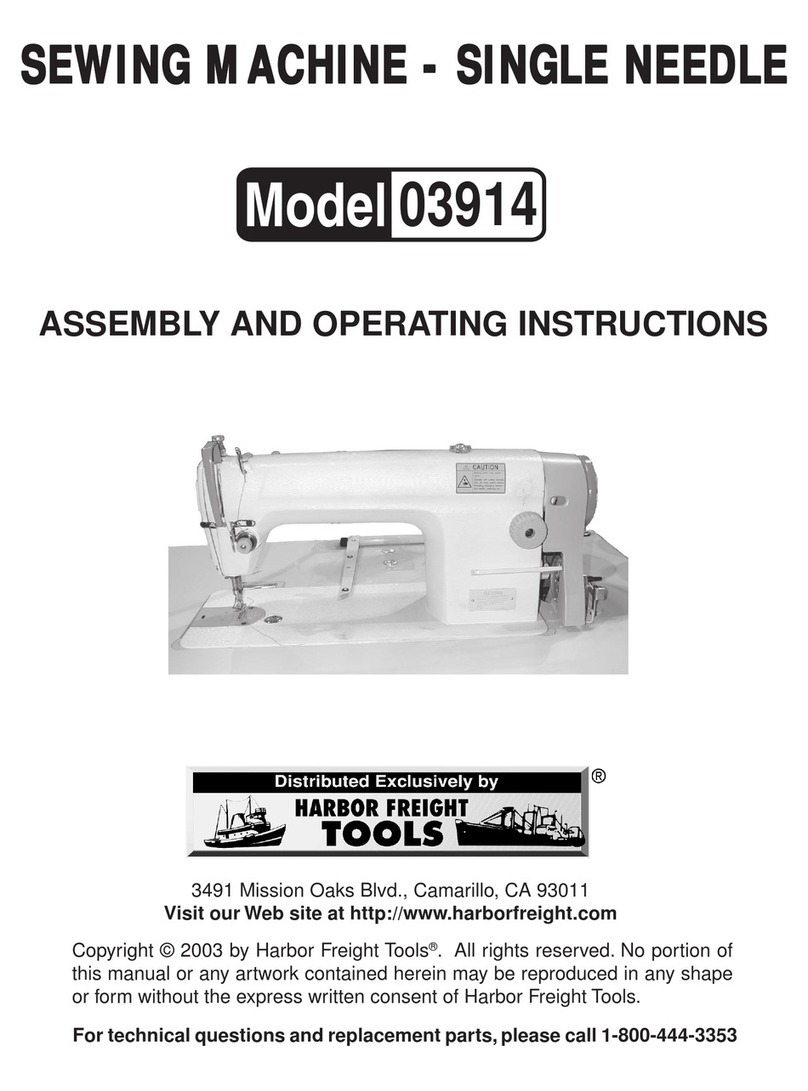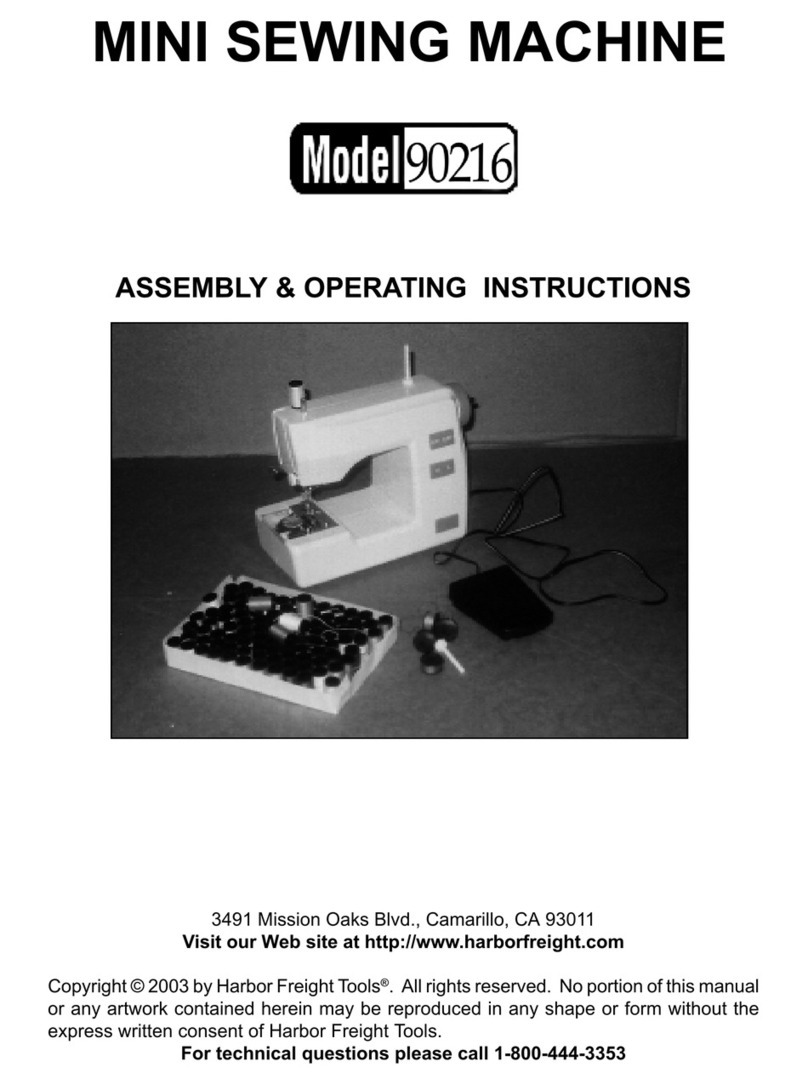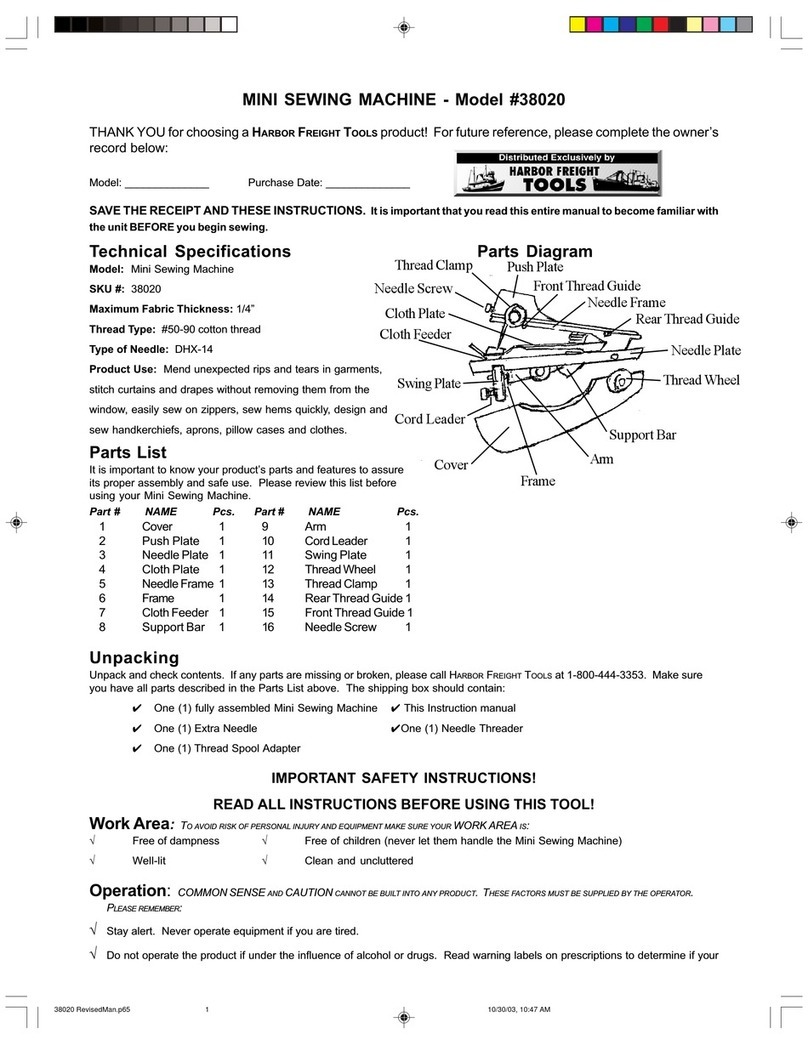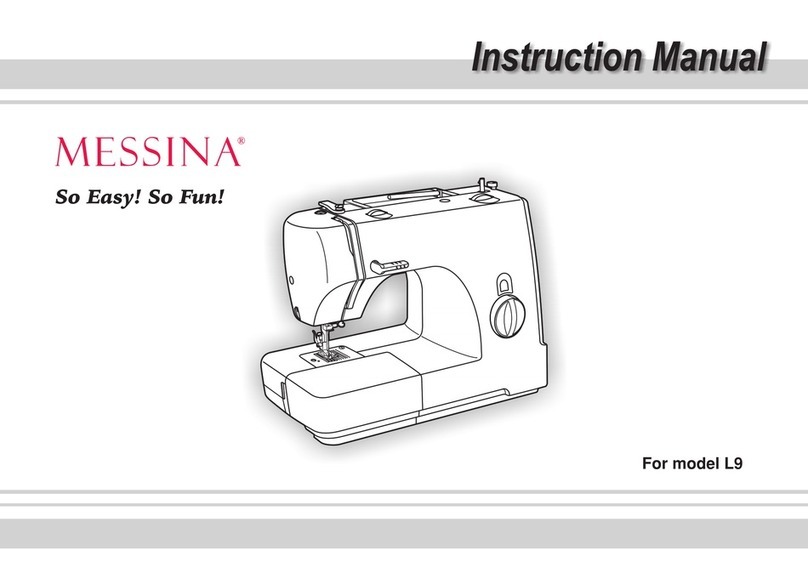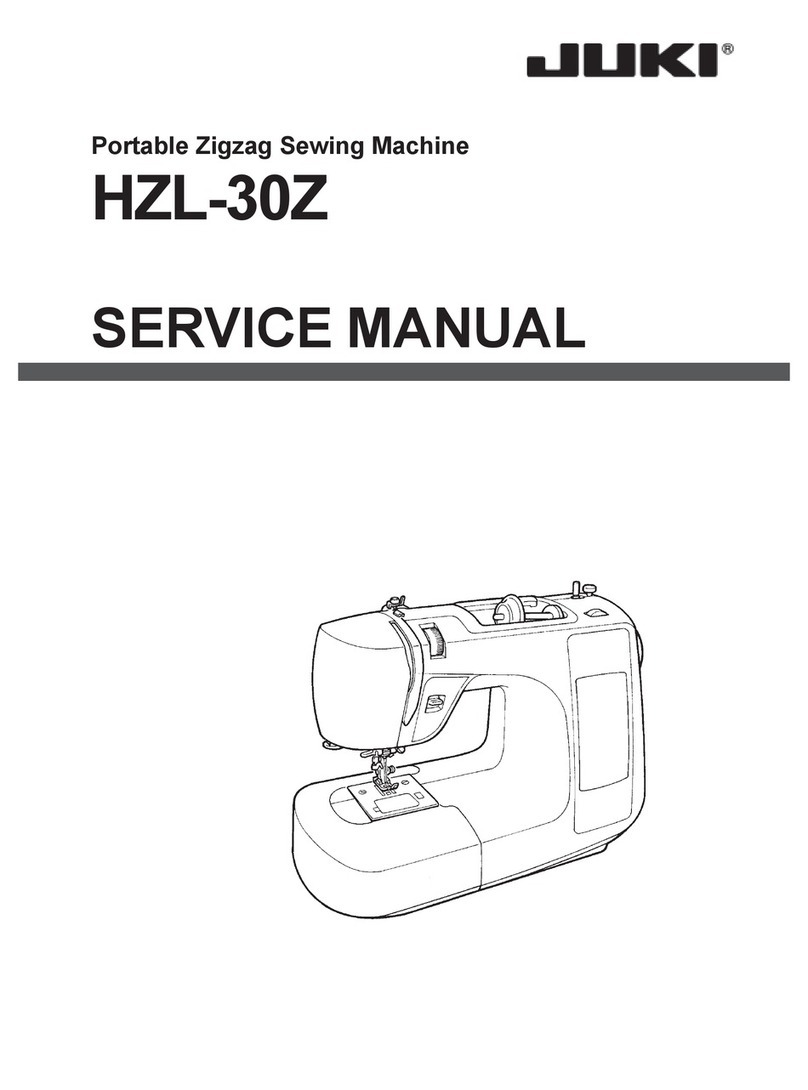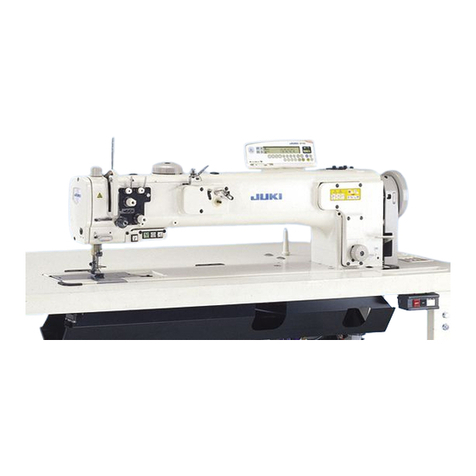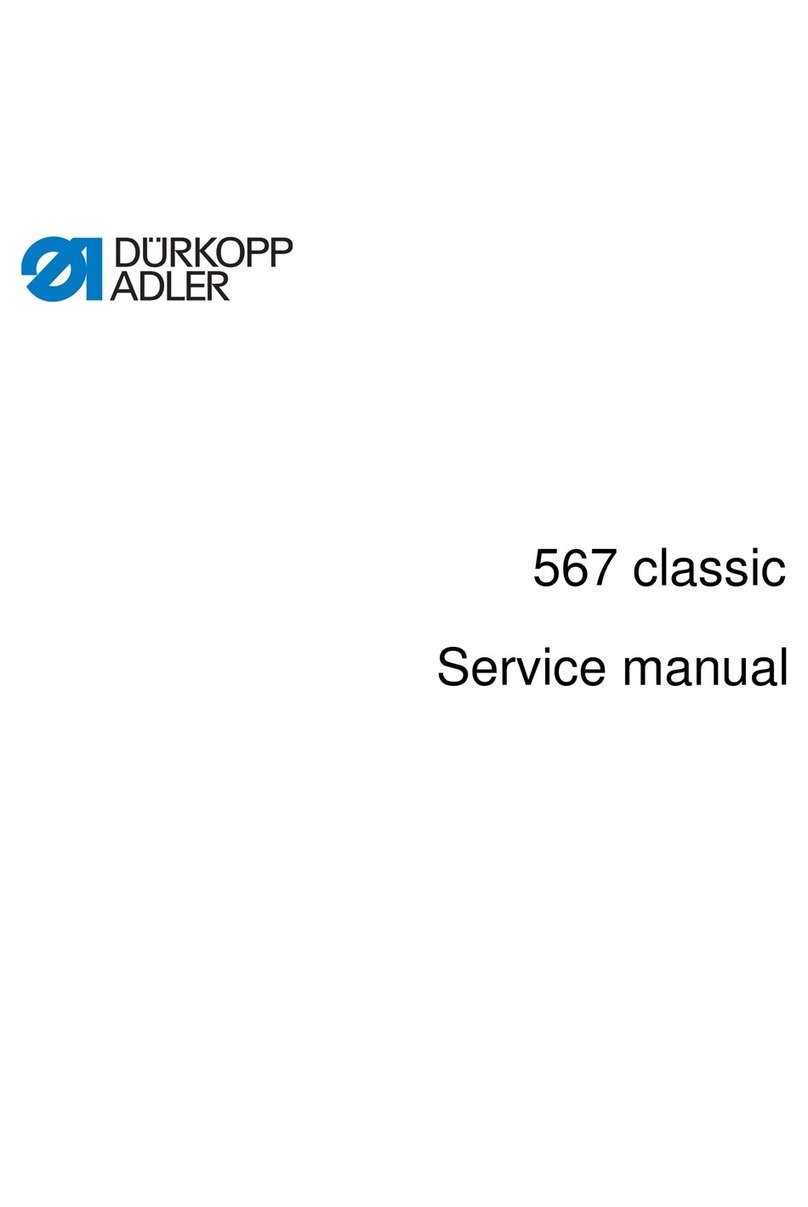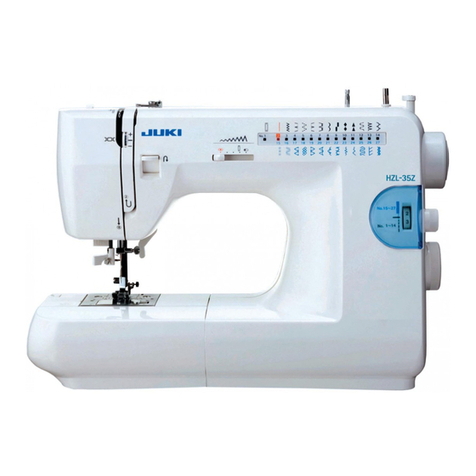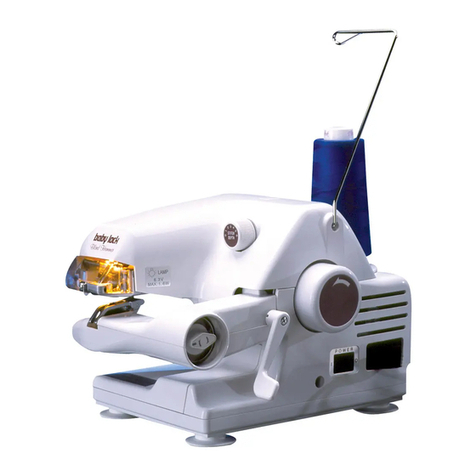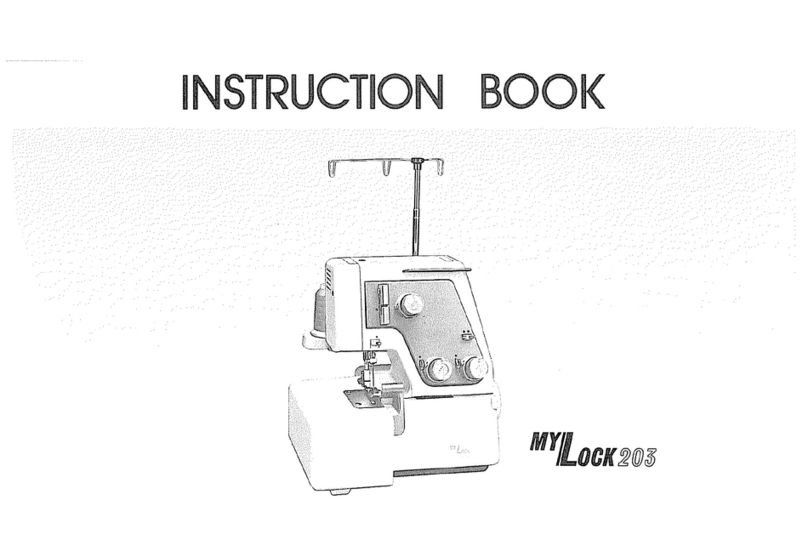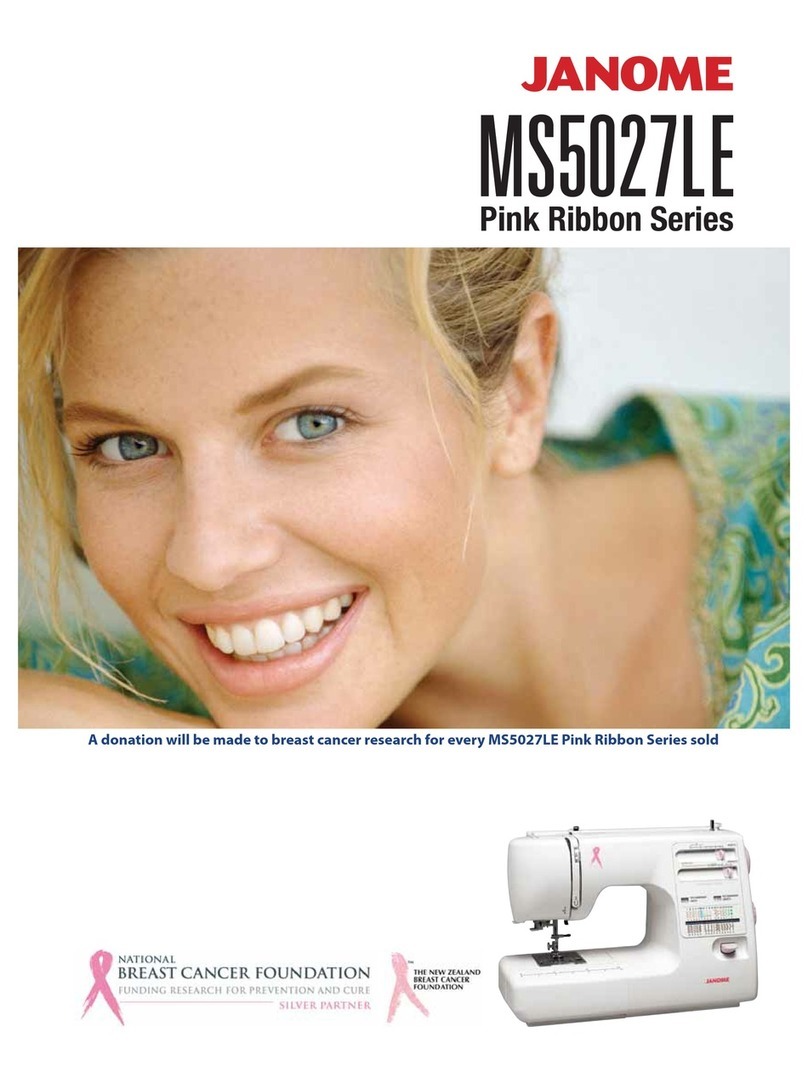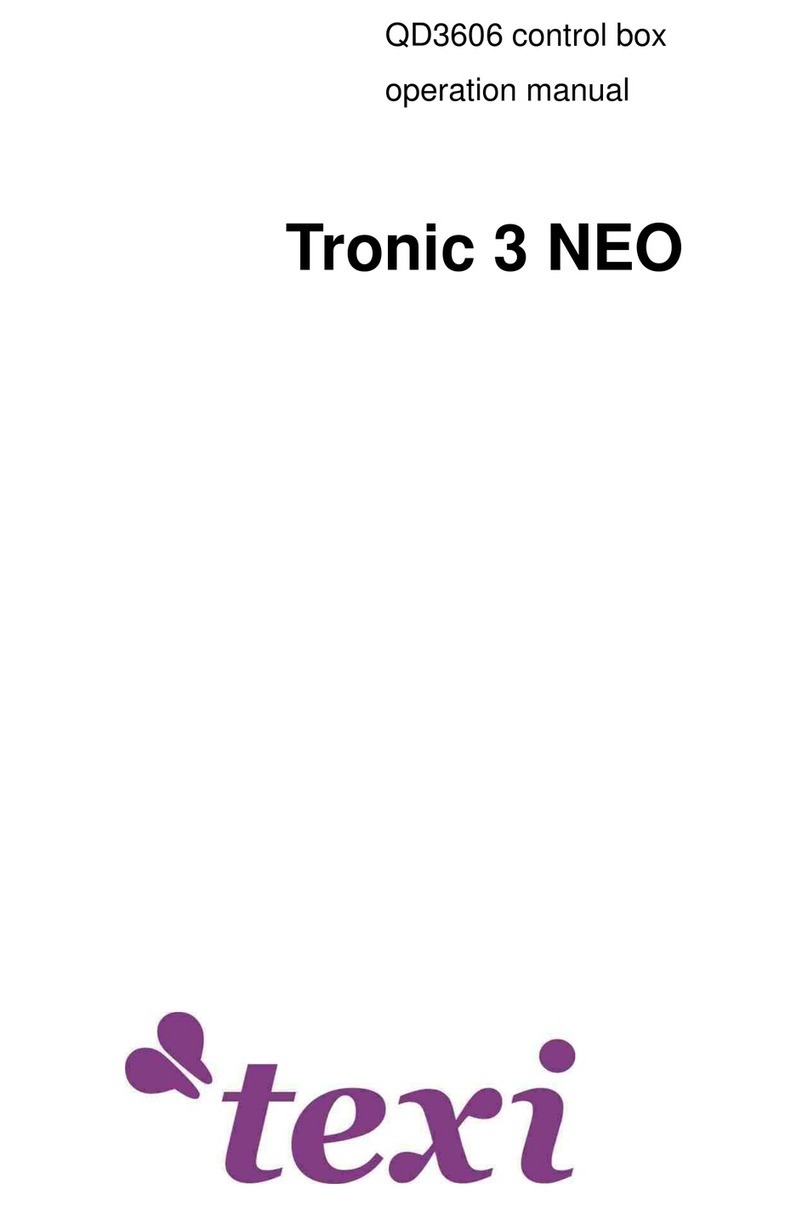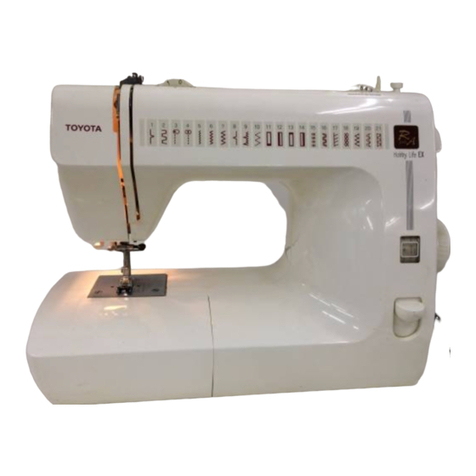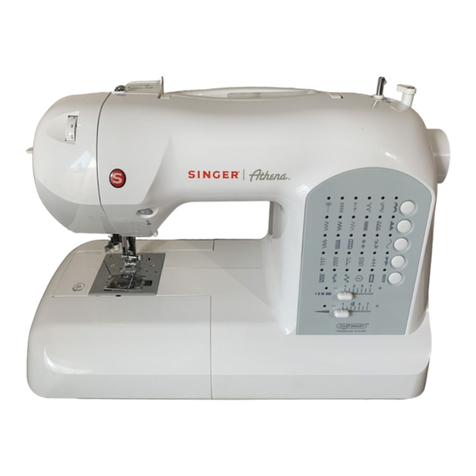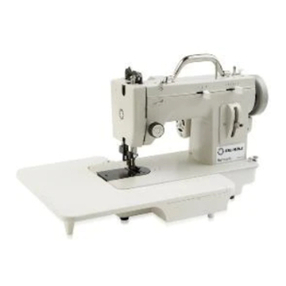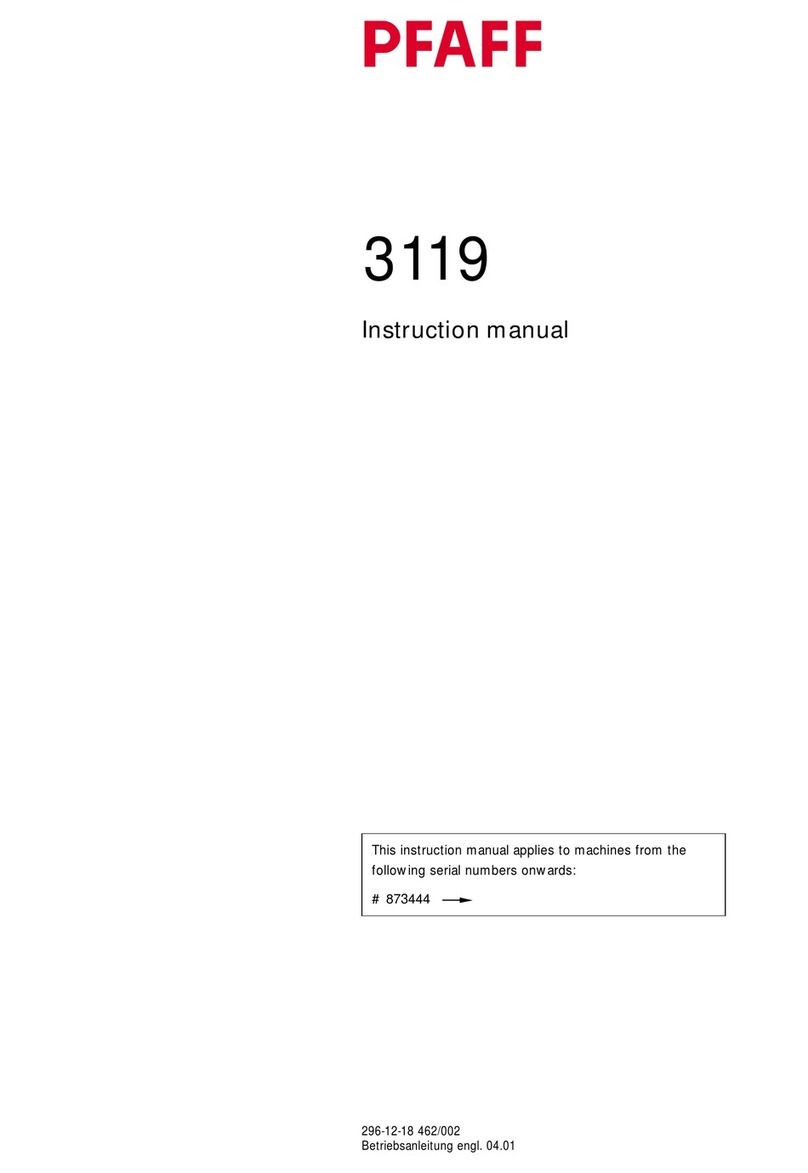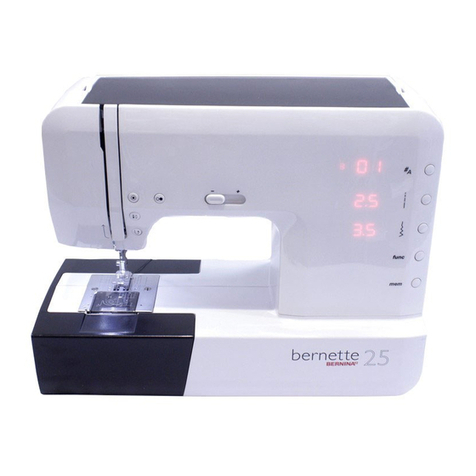Harbor Freight Tools 91500 User manual

OVERLOCK SEWING MACHINE
TWO NEEDLE - FOUR THREAD
Model 91500
ASSEMBLY AND OPERATING INFORMATION
3491 Mission Oaks Blvd., Camarillo, CA 93011
Visit our Web site at http://www.harborfreight.com
TO PREVENT SERIOUS INJURY,
READ AND UNDERSTAND ALL WARNINGS
AND INSTRUCTIONS BEFORE USE.
Copyright©2004 by Harbor Freight Tools®. All rights reserved. No portion of this
manual or any artwork contained herein may be reproduced in any shape or form
without the express written consent of Harbor Freight Tools.
For technical questions please call 1-800-444-3353.

PRODUCT SPECIFICATIONS
SAVE THIS MANUAL
Youwillneedthismanualforthesafetywarningsandprecautions,assembly,
operating, inspection, maintenance and cleaning procedures, parts lists, and
assemblydiagrams. Keep yourinvoicewith thismanual. Writetheinvoicenumber
on the inside of the front cover. Keep this manual and invoice in a safe and dry
place for future reference.
GENERAL SAFETY RULES
WARNING!
READ AND UNDERSTAND ALL INSTRUCTIONS
Failure to follow all instructions listed below may result in
electric shock, fire, and/or serious injury.
SAVE THESE INSTRUCTIONS
WORK AREA
1. Keep your work area clean and well lit. Cluttered and dark work areas invite
accidents.
When unpacking, check to make sure all parts shown on the Parts Lists on pages 21
through 38 are included. If any parts are missing or broken, please call Harbor Freight
Tools at the number shown on the cover of this manual as soon as possible.
UNPACKING
SKU 91500 PAGE 2
Item Description
Electrical Requirements 120 V / 60 Hz.
Power Switch Type: Rocker.
Power Cord Length: 6 Feet.
Power Plug Type: 2-Prong Double Insulated.
Sewing Speed 1300 SPM Maximum.
Machine Features Free Arm Style / Foot Control / Foot Pressure Adjustin
g
Knob
Twin Needle Sewing / 3 or 4 Threads (Over Locking).
Auto Cutting Knives/ Hand Wheel / Stitch Length Knob.
Left &Right Looper Thread Tension Dials / Thread Guide.
Right Thread Tension Dial / Hand Wheel / Carrying Handle.
Built-In Light.
Accessories 2mm Hex Key / 1.5mm Hex Driver / Small Screwdriver.
Flat Tweezers / Thumb Screwdriver / 10-Sewing Needles.
Overall Dimensions 11” W x 13” L x 11” H.
Weight 15.7 Pounds.

2. Do not operate electric appliances in explosive atmospheres, such as in the
presence of flammable liquids, gases, or dust. Electricappliancescreatesparks
which may ignite the dust or fumes.
3. Keep bystanders, children, and visitors away while operating electric
appliances. Distractions can cause you to lose control.
ELECTRICAL SAFETY
4. Grounded appliances must be plugged into an outlet properly installed and
grounded in accordance with all codes and ordinances. Never remove the
grounding prong or modify the plug in any way. Do not use any adapter
plugs. Check with a qualified electrician if you are in doubt as to whether the
outlet is properly grounded. If the appliance should electrically malfunction or
break down, grounding provides a low resistance path to carry electricity away
from the user.
5. Double insulated appliances are equipped with a polarized plug (one blade is
wider than the other). This plug will fit in a polarized outlet only one way. If
the plug does not fit fully in the outlet, reverse the plug. If it still does not fit,
contact a qualified electrician to install a polarized outlet. Do not change the
plug in any way. Double insulation eliminates the need for the three wire
grounded power cord and grounded power supply system.
6. Avoid body contact with grounded surfaces such as pipes,radiators,ranges,
and refrigerators. There is an increased risk of electric shock if your body is
grounded.
7. Do not expose electric appliances to rain or wet conditions. Water
entering an electric appliance will increase the risk of electric shock.
8. DonotabusethePower Cord. NeverusethePowerCordtocarrytheappliance
or pull the Plug from an outlet. Keep the Power Cord away from heat, oil,
sharp edges, or moving parts. Replace damaged Power Cords immediately.
Damaged Power Cords increase the risk of electric shock.
9. This appliance is intended for indoor use only.
PERSONAL SAFETY
10. Stay alert. Watch what you are doing,and use common sense when operating
an electric appliance. Do not use an electric appliance while tired or under
the influence of drugs, alcohol, or medication. A moment of inattention while
operating an electric appliance may result in serious personal injury.
SKU 91500 PAGE 3

11. Dress properly. Do not wear loose clothing or jewelry. Contain long hair.
Keep your hair, clothing, and gloves away from moving parts. Loose clothes,
jewelry, or long hair can be caught in moving parts.
12. Avoid accidental starting. Be sure the Power Switch is off before plugging in.
Carrying electric appliances with your finger on the Power Switch, or plugging in
electric appliances with the Power Switch on, invites accidents. Make sure you are
prepared to begin work before turning the Power Switch “ON”.
13. Remove adjusting keys or wrenches before turning the electric appliance on.
A wrench or a key that is left attached to a rotating part of the electric appliance
may result in personal injury.
14. Do not overreach. Keep proper footing and balance at all times. Properfooting
andbalanceenablesbetter control of anelectricappliance inunexpected situations.
15. Always wear eye protection. Wear ANSI approved safety impact eye
glasses. ANSIapproved safety impact eye glasses areavailablefromHarbor
Freight Tools.
TOOL USE AND CARE
17. Do not force the electric appliance. Use the correct appliance for your
application. The correct appliance will do the job better and safer at the rate for
which it is designed. There are certain applications for which this Sewing Machine
was designed. Do not use this Sewing Machine to do the work of a larger Sewing
Machine. Do not use this product for a purpose for which it was not intended.
18. Do not use the Sewing Machine if the Power Switch does not turn it on or off.
Anyelectric appliance thatcannot be controlled with thePower Switch is dangerous
and must be replaced.
19. Disconnect the Power Cord Plug from the power source before making
anyadjustments, changing accessories, or storing the Sewing Machine.
Such preventive safety measures reduce the risk of starting the appliance
accidentally.
20. Store idle electric appliances out of reach of children and other untrained
persons. Electric appliances are dangerous in the hands of untrained users.
21. Maintain tools with care. Keep cutting tools sharp and clean. Properly
maintained tools with a sharp cutting edge are less likely to bind and are easier to
control. Do not use a damaged tool. Tag damaged tools “Do not use”until repaired.
22. Check for misalignment or binding of moving parts, breakage of parts, and
any other condition that may affect the operation of the appliance. If damaged,
have the appliance serviced before using. Manyaccidents are causedby poorly
maintained appliances.
SKU 91500 PAGE 4

WARNING!
Improperly connecting the grounding wire can result in the risk of electric
shock. Check with a qualified electrician if you are in doubt as to whether the
outlet is properly grounded. Do not modify the power cord plug provided with
the appliance. Never remove the grounding prong from the plug. Do not use
the appliance if the power cord or plug is damaged. If damaged, have it
repaired by a service facility before use. If the plug will not fit the outlet,
have a proper outlet installed by a qualified electrician.
23. Use only accessories that are recommended by the manufacturer for your
model. Accessoriesthatmaybesuitableforone appliance may becomehazardous
when used on another appliance.
SERVICE
24. Appliance service must be performed only by qualified repair personnel.
Service or maintenance performed by unqualified personnel could result in a risk of
injury.
25. When servicing an appliance, use only identical replacement parts. Follow
instructions in the
“Inspection, Maintenance, And Cleaning”
section of this
manual. Use of unauthorized parts or failure to follow maintenance instructions
may create a risk of electric shock or injury.
GROUNDING
DOUBLE INSULATED APPLIANCES: APPLIANCES WITH TWO PRONG PLUGS
1. Appliances marked “Double Insulated” do not require grounding. They have a
special double insulation system which satisfies OSHA requirements and com-
plies with the applicable standards of Underwriters Laboratories, Inc., the Cana-
dian Standard Association, and the National Electrical Code. (See Figure A.)
2. Double insulated tools may be used in either of the 120 volt outlets shown in the
following illustration. (See Figure A.)
FIGURE A
SKU 91500 PAGE 5

EXTENSION CORDS
1.
Grounded
tools require a three wire extension cord.
Double Insulated
tools
can use either a two or three wire extension cord.
2. As the distance from the supply outlet increases, you must use a heavier gauge
extension cord. Using extension cords with inadequately sized wire causes a
serious drop in voltage, resulting in loss of power and possible tool damage.
(See Figure B.)
3. The smaller the gauge number of the wire, the greater the capacity of the cord.
For example, a 14 gauge cord can carry a higher current than a 16 gauge cord.
(See Figure B.)
4. If using more than one extension cord to make up the total length, make sure
each cord contains at least the minimum wire size required.
5. If you are using one extension cord for more than one appliance, add the name-
plate amperes and use the sum to determine the required minimum cord size.
(See Figure B.)
6. If you are using an extension cord outdoors, make sure it is marked with the
suffix “W-A” (“W” in Canada) to indicate it is acceptable for outdoor use.
7. Make sure your extension cord is properly wired and in good electrical condition.
Always replace a damaged extension cord or have it repaired by a qualified
electrician before using it.
8. Protect your extension cords from sharp objects, excessive heat, and damp or
wet areas.
RECOMMENDED MINIMUM WIRE GAUGE FOR EXTENSION CORDS
*
(120 VOLT)
NAMEPLATE
AMPERES
(
At Full Load
)
EXTENSION CORD LENGTH
25
Feet 50
Feet 75
Feet 100
Feet 150
Feet
0 – 2.0 18 18 18 18 16
2.1 – 3.4 18 18 18 16 14
3.5 – 5.0 18 18 16 14 12
5.1 – 7.0 18 16 14 12 12
7.1 – 12.0 18 14 12 10 -
12.1 – 16.0 14 12 10 - -
16.1 – 20.0 12 10 - - -
* Based on limiting the line voltage drop
to five volts at 150% of the rated amperes.
FIGURE B
SKU 91500 PAGE 6

SYMBOLOGY
V ~
A
xxxx/min.
Double Insulated
Canadian Standards
Association
Underwriters
Laboratories, Inc.
Volts Alternating Current
Amperes
No Load Revolutions
per Minute (RPM)
no
SPECIFIC SAFETY RULES
1. Maintain labels and nameplates on the Sewing Machine. Thesecarry important
information. Ifunreadableormissing,contactHarborFreightToolsfor a replacement.
2. Check for damaged parts. Before using this product, carefully check that it will
operate properly and perform its intended function. Check for damaged parts and
any other conditions that may affect the operation of this product. Replace or repair
damaged or worn parts immediately.
3. Keep fingers and hands away from the Needle when you turn the Power Switch
on, or while the Sewing Machine is operating.
4. Always disconnect the Sewing Machine from its electrical outlet before
performing any services, maintenance, or cleaning such as leaving the work
area, moving the machine from one location to another, changing Needles/Thread,
cleaning debris from the unit, etcetera. Never attempt to remove material stuck in
the moving parts of the Sewing Machine while it is plugged in. Never perform
layout, assembly, or setup work on the Table of the Sewing Machine when the
machine is plugged in.
5. Beforeuse,theSewing Machine should be placedonaflat,stable table surface,
capableofsupportingthe weight of the machine, workpiece, and anyadditional
pressure caused by working on it.
6. During operation, never place your head, hair, or hands in the proximity of
the Hand Wheel, Bobbin Winder, or motor.
7. Do not operate the Sewing Machine with any safety guards removed.
8. Use caution when threading the machine. Certain parts such as the Loopers,
Needles, and Knives are very sharp.
FIGURE C
SKU 91500 PAGE 7

9. Never use bent or dull needles. Shut off and unplug the Sewing Machine and
promptly replace a bent or dull needle with one that is in proper working condi-
tion.
10. Push or pull the fabric slowly when sewing. Pushing or pulling the fabric too
quickly may break the needle.
11. Always keep the Foot Controller free of dust, yarn, fabric, and other debris.
12. Never pour any liquids or insert any objects into the openings of the Sew-
ing Machine.
13. WARNING! People with pacemakers should consult their physician(s) before
using this product. Electromagnetic fields in close proximity to a heart pace-
maker could cause interference to or failure of the pacemaker.
14. WARNING! Thewarnings,precautions,andinstructions discussed in this instruction
manual cannot cover all possible conditions and situations that may occur. It must
be understood by the operator that common sense and caution are factors which
cannot be built into this product, but must be supplied by the operator.
PRODUCT FEATURES
(Machine With Cover Open)
UPPER
KNIFE
PRESSER
FOOT
SPANNER
LOWER KNIFE
LEFT LOOPER
FEED
ADJUSTING
KNOB
RIGHT
LOOPER
(55A)
(55A)
(14B)
(55A)
(55A)
(38A)
(30A)
(13A)
(24A)
(9F)
(21E)
(1A)
(9A)
FIGURE D
(18F)
9A. THREAD BRACKET ASS’Y.
55A. THREAD TENSION REGULATING WHEEL.
14B. ADJUSTING SCREW.
30A. NEEDLE APPROACHER.
13A. MOVEABLE SEWING TABLE.
38A. UPPERTHREAD GUIDE.
24A. LOOPER COVER.
9F. HAND WHEEL.
21E. FEED ADJUSTING KNOB.
1A. THREAD RACK BRACKET.
18F. POWER SWITCH.
32F. LAMP.
(32F)
SKU 91500 PAGE 8

PREPARING THE SEWING MACHINE FOR USE
NOTE: For additional references to the parts listed in the following pages, refer to the
Assembly Diagrams on pages 23 through 38 of this manual.
To Thread The Sewing Machine:
1. CAUTION! Prior to performing this procedure, make sure the Power Switch
(18F) of the Sewing Machine is in its “OFF” position and the Power Wire
(29F) is unplugged from its electrical receptacle.
(See Figure D, page 8, and Figure I, page 12.)
2. Remove the Moveable Sewing Table (13A) from the Needle Approacher (30A) by
pulling the Table to the left. Then lift the Table upward and off the Sewing
Machine. (See Figure E.)
3. Turn the Hand Wheel (9F) toward you until the Needle Holder (21B) is at its high-
est position. Loosen the two Setting Screws (23B) with the Hex Driver (7G).
Insert two new Needles (26B) into the Needle Holder as far as they will go
with their
flat
surfaces to the BACK. Then, re-tighten the two Setting Screws to
secure the Needles in place. (See Figures D and F.)
SKU 91500 PAGE 9 REV 12/04
NEEDLE HOLDER
(21B)
NEEDLE
(26B)
SETTING SCREW
(23B)
FIGURE F
MOVEABLE SEWINGTABLE (13A)
NEEDLE APPROACHER
(30A)
FIGURE E

4. Set up the Thread Bracket Assembly (9A), and insert a spool of thread (not
included) onto each of the
four
Cones located on the Spool Stand (1A).
(See Figure G.)
5. Loop the four strands of thread through the Wire Hooks on the Thread Bracket
Assembly (9A) and on the UpperThread Guide (38A). (See Figure G.)
6. Insert the four strands of thread into the slots on the left side of each Tension Dial
(55A). NOTE: Make sure to allow approximately 18” length of excess thread
hanging from each Tension Dial. (See Figure G.)
WIRE HOOK
UPPERTHREAD GUIDE
(38A)
FRONT COVER
PLATE
(67A)
TENSION DIAL
(55A)
THREAD BRACKET ASSY.
(9A)
THREAD SPOOL
(NOT INCLUDED)
THREAD RACK
BRACKET
(1A)
FIGURE G
7. Open the Looper Cover (24A) by pushing it as far to the right as it will go. Then,
pull it downward. (See Figure D.)
8. When the Looper Cover (24A) is opened the interior mechanisms of the Sewing
Machine are exposed. As an aid in threading the four strands of thread through
the various mechanisms
each mechanism is color coded
to correspond with each
individual spool of thread. In example:
RED = SPOOL #1
YELLOW = SPOOL #2
GREEN = SPOOL #3
TURQUOISE = SPOOL #4
(See Figure H, next page.)
SKU 91500 PAGE 10

SKU 91500 PAGE 11
FIGURE H
LEFT
LOOPER
(17C)
RIGHT
LOOPER
(30C)
NEEDLE
(26B) NEEDLE
(26B)
FRONTVIEW
(WITH LOOPER COVER (24A) OPEN)
SPOOL #4
(TURQUOISE) SPOOL #3
(GREEN) SPOOL #1
(RED) SPOOL #2
(YELLOW)
4
3
4
3
2
2
2
2
2
2
1
1
1
1
1
1

9. Thread each of the four strands of thread along its respective color-coded ma-
chine mechanism as shown in the previous illustration. (See Figure H.)
10. When finished threading the Sewing Machine, replace the Moveable Sewing
Table(13A). Then, close the Looper Cover (24A). (See Figure D.)
To Attach The Pedal Switch Assembly:
1. CAUTION! Before use, the Sewing Machine should be placed on a flat, stable
table surface, capable of supporting the weight of the machine, fabric, and any
additional pressure caused by working on it.
2. Insert the Pedal Switch Plug into the machine socket. Then set the Pedal Switch
Assembly (33F) on the floor under the table. (See Figure I.)
3. Plug the Power Wire (29F) into the nearest 120 volt, grounded, electrical
receptacle. (See Figure I.)
4. NOTE: Press on the Pedal Switch Assembly (33F) strongly, and the sewing
speed increases. Press on the Pedal Switch Assembly lightly, and the sewing
speed decreases. (See Figure I.)
5. CAUTION! Always make sure no fabrics or other objects are left laying on top of
the Pedal Switch Assembly (33F). (See Figure I.)
(Right Side View)
POWER WIRE
(29F)
MACHINE
SOCKET FOOT SWITCH
PLUG PEDAL SWITCH ASSY.
(33F)
FIGURE I
SKU 91500 PAGE 12

OPERATING THE SEWING MACHINE
To AdjustTheThreadTension:
1. Adjust thread tension to suit the type of material and size of the thread used. The
Tension Dials (55A) on the Sewing Machine are a one-turn system. By turning
the Tension Dials up toward the +mark the thread tension becomes tighter. By
turning the Tension Dials down toward the -mark the thread tension becomes
looser. Thread tension can be adjusted independent of each other. For example,
the Left Looper thread can be adjusted to be tighter or looser than the Right
Looper thread. (See Figure G.)
PRESSER FOOT
ASSY.
(1B)
PRESSER FOOT
SPANNER
(9B)
FIGURE J
SKU 91500 PAGE 13
To ChangeThreads:
1. To change threads, first cut each thread near the Thread Spool (not included).
Remove the old spool and replace with a new one. Tie the end of the new thread
to the end of the old one, using a small knot that will pass easily through the
machine. Raise the Presser Foot Spanner (9B). Turn the Tension Dials (55A)
down toward the -mark until the Dial stops and pull the thread out so that the tie
knot of the thread extends from the Presser Foot Assembly (1B). When inserting
the thread through the Needle (26B) eye, stop the tie knot before the Needle eye.
Then, cut the thread and pass it through the Needle eye. (See Figure G and
Figure J.)

To Adjust The Stitch Length:
1. The stitch length is adjustable within the range from 1 to 5. For normal over
locking stitches set the Feed Adjusting Knob (21E) at 2 or 3. (See Figure K.)
FEED ADJUSTING KNOB
(21E)
To AdjustThe Feeding For Gathering Or Stretching:
1. To adjust feeding for gathering or stretching turn the Differential Feed Adjusting
Stud (93E) upward or downward. (See Figure L.)
FIGURE K
(Sewing Machine With Cover Open)
DIFFERENTIAL FEED
ADJUSTING STUD
(93E)
To Replace / AdjustThe Upper Knife:
1. CAUTION! Make sure the Power Switch (18F) is in its “OFF” position and the
Power Wire (29F) is unplugged from its electrical outlet before performing this
procedure. Use caution when handling or working around knives, loopers, or
other sharp parts. (See Figure D and Figure I.)
FIGURE L
SKU 91500 PAGE 14

To ReplaceThe Lower Knife:
1. CAUTION! Make sure the Power Switch (18F) is in its “OFF” position and the
Power Wire (29F) is unplugged from its electrical outlet before performing
this procedure. (See Figure D and Figure I.)
2. Turn the Hand Wheel (9F) until the Upper Knife (2D) is fully raised. Loosen the
Screw (1D) slightly. (See Figure D and Figure M.)
3. Open the Looper Cover. (See Figure D.)
4. To Remove The Upper Knife (2D):
a. Press the Upper Knife Bracket Rotating Shaft (5D) toward the right until it will
go no further. (See Figure M.)
b. Turn the Setting Ring (14D) in the direction of the arrow slightly. Stop press-
ing the Shaft and continue turning the Ring until the slot in the edge is ex-
posed. (See Figure M.) Insert the wide end of the Key (3g) into the slot.
c. Remove the Screw (1D) and old Upper Knife (2D). Install the new or resharp-
ened Knife with the Screw (1D) near the middle of the slot in the Knife.
Tighten the Screw enough to hold the Knife while allowing it to slide.
(See Figure M.)
d. Turn the Setting Ring (14D) in the direction opposite the one shown in Figure
M. When the blade is lined up properly it should snap back to the left with
gentle pressure.
5. If the Knife is adjusted properly, when the Upper Knife is completely lowered the
edge of the Upper Knife (2D) should just barely overlap the entire edge of the
Lower Knife (28D). If necessary, carefully slide the Upper Knife until it is in the
correct position.
6. Retighten the Screw (1D) to fix the Upper Knife in place. (See Figure M.)
UPPER KNIFE
(2D) SCREW
(1D)
UPPER KNIFE BRACKET
(3D)
FIGURE M
UPPER KNIFE BRACKET
ROTATING SHAFT
(5D)
SETTING RING
(14D)
UPPER
KNIFE
BRACKET
(3D)
SKU 91500 PAGE 15
SLOT

To AdjustThe Pressure OnThe Pedal Switch Assembly:
1. The pressure setting on the Pedal Switch Assembly (33F) has been factory set
and should only be adjusted when sewing a special material. (See Figure I.)
2. Turn the Adjusting Screw (14B) clockwise to increase pressure for heavy-weight
materials such as denim, tweed, or hard linen. (See Figure D.)
3. Turn the Adjusting Screw (14B) counterclockwise to decrease pressure for light-
weight materials such as georgette, lawn, or tricot.
(See Figure D.)
3Thread And 4Thread Overlock:
1. This is a two Needle/4 thread overlock Sewing Machine. One Needle/three
thread overlock can be done by means of using only the left or right Needle and
three threads. When using only one Needle, make sure to remove the other
Needle. (See Figure N and Figure O.)
SKU 91500 PAGE 16 REV 12/04
2. Set the Upper Knife (2D) in its non-operating position as described in steps 4-a
and 4-b under
To Replace / Adjust the Upper Knife
on page 15.
(See Figure M.)
3. Loosen the Screw (30D), and remove the Lower Knife Pressure Plate (29D) and
the old Lower Knife (28D).
4. Place a new Lower Knife (28D) in the groove of the Lower Knife Bracket (27D),
and align the cutting edge slightly below the top of the Needle Plate (1E). Re-
place the Lower Knife Pressure Plate (29D) and tighten the Screw (30D). Then,
return the Upper Knife (2D) to its original position. (See Figure D and Figure M.)
RIGHT LOOPERTHREAD (TOPSIDE)
LEFT NEEDLETHREAD
RIGHT NEEDLETHREAD
LEFT LOOPERTHREAD
(UNDERSIDE)
FIGURE N

To Perform Roll Hemming:
1. This Sewing Machine can do right looper thread/wrapped rolled hem stitching
with a seam width of approximately 1/16”. When doing so, always remove the
left Needle.
2. Rolled hemming is done by rolling the fabric and overedging, and is not suited for
heavy or stiff fabrics.
3. CAUTION! Make sure the Power Switch (18F) is in its “OFF” position and the
Power Wire (29F) is unplugged from its electrical outlet before performing
this procedure. (See Figure D and Figure I.)
4. To perform roll hemming, set the Feed Adjusting Knob (21E) to “2” or “F”.
(See Figure D.)
5. Turn the Hand Wheel (9F) toward you until the Needle (26B) is at its highest
point. (See Figure D and Figure F.)
6. Lift the Presser Foot Assembly (1B). (See Figure J.)
7. Remove the Moveable Sewing Table (13A). (See Figure D.)
8. Unscrew the
two
Needle Plate Screws (5E, 6E) and remove the Needle Plate
(1E). (See Figure D and Figure P.)
SKU 91500 PAGE 17
3THREAD
1/4” (5MM)
LEFT NEEDLE
3THREAD
1/8” (3.5MM)
RIGHT NEEDLE
4THREAD
1/4” (5.7MM)
LEFT & RIGHT NEEDLE
STITCHTYPE
FIGURE O
NO. OFTHREAD
OVERLOCK WIDTH
NEEDLE USED

SKU 91500 PAGE 18
To Perform Free Arm Sewing (Tubular Work):
1. This Sewing Machine can achieve tubular work by removing the Moveable Sew
ing Table (13A). This is especially convenient for finishing hard-to-reach areas
such as arm holes, overcasting trouser cuffs, etc. (See Figure D.)
9. Install a Hem Needle Plate Assembly (2E - not included), and replace the two
Needle Plate Screws (5E, 6E). (See Figure D and Figure P.)
10. Replace the Moveable Sewing Table (13A). (See Figure D.)
11. For rolled hemming, adjust the seam width to the position of “M” on the Hem
Needle Plate (3E). Then align the left edge of the Lower Knife Bracket (27D)
with the “M” mark on the Hem Needle Plate. (See Figure M.)
12. NOTE: Make sure the Lower Knife (28D) is not in contact with the edge of the
Hem Needle Plate (3E). When performing rolled-hem stitching, make sure to
adjust the thread tension correctly. At the start of sewing, slightly pull the end of
the chain off so it will not be entangled in the stitch.
(See Figure M and Figure P.)
HEM NEEDLE PLATE
(3E)
NEEDLE PLATE
SCREW
(5E)
FIGURE P
NEEDLE PLATE
SCREW
(6E)
To Perform Gathering:
1. A single layer of light weight fabric can be gathered to achieve sleeve heads,
lower edges, yokes, leca edging, or frills. To do so, set the Feed Adjusting Knob
(21E) at its maximum “5”. Set the Differential Feed Adjusting Stud (93E) from
“1.5” to “2”. (See Figure D.)

Troubleshooting Guide:
Condition Reason Method of Adjustment
Fabric is not feeding. Insufficient Foot
Controller pressure. Increase pressure on
Foot Controller.
Needle breaks. Needle not inserted properly.
Fabric being pulled too fast.
Loose Needle Set Screw.
Insert Needle correctly or
replace with correct Needle.
Do not pull fabric by hand.
Use hand only to guide fabric.
Tighten Set Screw firmly.
Thread breaks. Incorrect threading.
Bent or damaged Needle.
Thread tension too tight.
Thread tangled.
Needle inserted incorrectly.
Thread machine correctly.
Replace Needle.
Adjust tension.
Thread correctly.
Insert Needle correctly.
Stitches skip. Bent Needle or Needle
point damage.
Needle set loosely.
Incorrect threading.
Wrong Needle used.
Insufficient Foot
Controller pressure.
Replace Needle.
Set Needle firmly in position.
Thread machine correctly.
Use correct Needle.
Increase pressure on
Foot Controller.
Stitches are irregular. Thread tension not balanced. Adjust tension.
Fabric puckers. Thread tension too tight.
Threading incorrect or tangled.
Differential Feed Dial at
wrong ratio.
Adjust tension.
Rethread machine.
Set value of Differential Feed
Dial at 0.7-N.
Machine does not operate. Power Cord Plug not connected. Connect Power Cord Plug to a
120 volt, grounded, electrical
receptacle.
SKU 91500 PAGE 19
Thread And Needle Suggestions For Certain ClothTypes:
Muslin,
Denim
Knit
Wool (woven, knit)
Cloth Thread Needle

SKU 91500 PAGE 20
INSPECTION, MAINTENANCE, AND CLEANING
1. WARNING! Always disconnect the Sewing Machine from its electri-
cal power supply source before performing any inspection, mainte-
nance, or cleaning procedure.
2. Before each use, inspect the general condition of the Sewing Machine. Inspect the
Power Switch, Power Plug and Cord assembly, and extension cord (if used) for
damage. Check for loose screws, misalignment, binding of moving parts, broken,
cracked, or improper mounting of the Needles, broken parts and any other condi-
tion that may affect its safe operation. If abnormal noise or vibration occurs, turn off
the Sewing Machine immediately and have the problem corrected before further
use. Do not use damaged equipment.
3. Always remove cut-off pieces and scraps of fabric from the Sewing Machine and
Foot Controller before starting the machine.
4. With a brush, soft cloth, or vacuum, remove all debris from the Sewing Machine.
Do not use solvents to wipe off the Sewing Machine, as damage may result. If
necessary, wipe with a damp cloth. You may use a mild detergent. Warning! Do
not introduce any liquids into the openings of the Sewing Machine.
5. Onceclean,lubricateallmovingparts witha light SewingMachineoil(not included).
6. When storing, keep the Sewing Machine covered with a cloth cover (not included).
7. To change the 120 volt Lamp (32F) in the Sewing Machine, pull out and remove the
left side section of the Lamp Cover (62A) to expose the Lamp.
CAUTION! Make sure the Lamp is completely cool before touching. Unscrew and
remove the old Lamp from its socket, and replace with a new 120 volt Lamp. Then,
replace the Lamp Cover. (See Figure D.)
8. Repairs should only be performed by a qualified sewing machine technician.
PLEASE READ THE FOLLOWING CAREFULLY
THE MANUFACTURER AND/OR DISTRIBUTOR HAS PROVIDED THE PARTS
DIAGRAM IN THIS MANUAL AS A REFERENCE TOOL ONLY. NEITHER THE
MANUFACTURER NOR DISTRIBUTOR MAKES ANY REPRESENTATION OR
WARRANTY OF ANY KINDTOTHE BUYERTHAT HE OR SHE IS QUALIFIEDTO MAKE
ANY REPAIRSTOTHE PRODUCT ORTHAT HE OR SHE IS QUALIFIEDTO REPLACE
ANY PARTS OF THE PRODUCT. IN FACT, THE MANUFACTURER AND/OR
DISTRIBUTOR EXPRESSLY STATES THAT ALL REPAIRS AND PARTS
REPLACEMENTS SHOULD BE UNDERTAKEN BY CERTIFIED AND LICENSED
TECHNICIANS AND NOT BY THE BUYER. THE BUYER ASSUMES ALL RISK AND
LIABILITY ARISING OUT OF HIS OR HER REPAIRSTOTHE ORIGINAL PRODUCT OR
REPLACEMENT PARTSTHERETO,OR ARISING OUT OF HIS OR HER INSTALLATION
OF REPLACEMENT PARTSTHERETO.
Table of contents
Other Harbor Freight Tools Sewing Machine manuals
